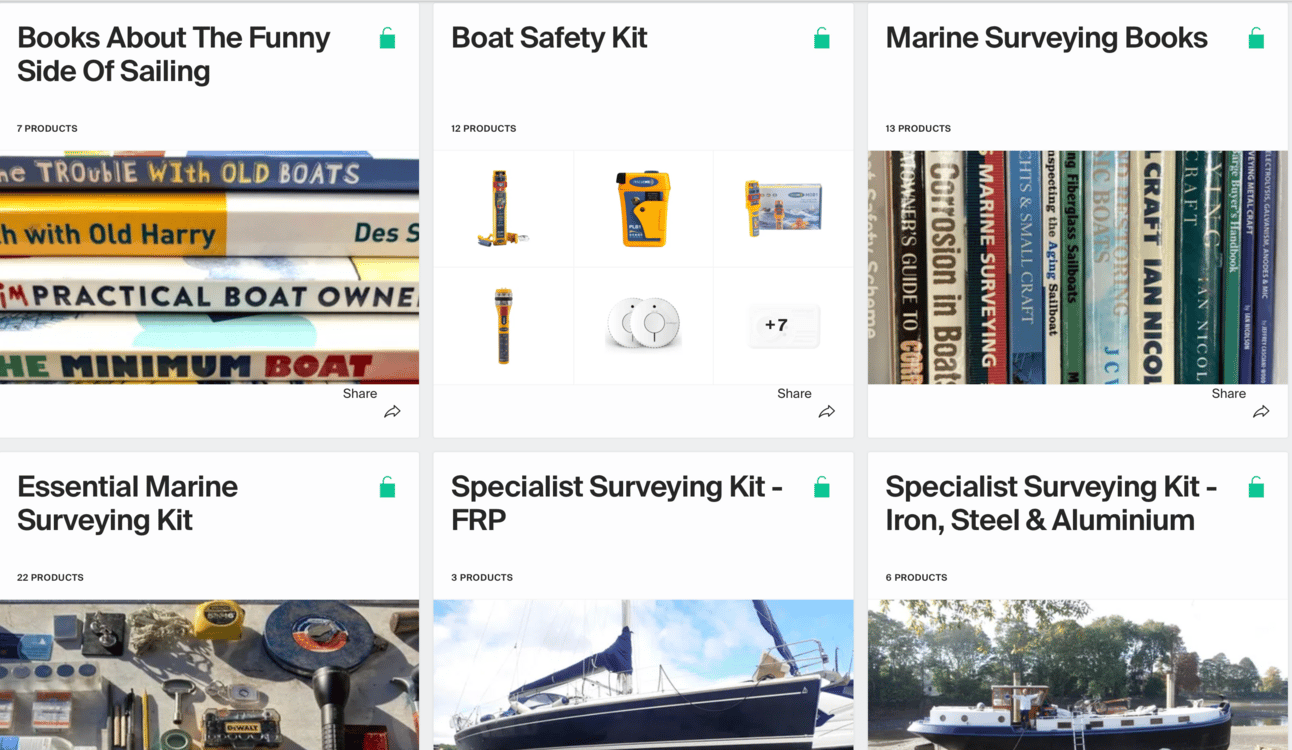
Boat Chat’s mission is to ‘Help people understand boats better’. It is published bi-monthly with a mixture of maritime news, maintenance advice, surveying tips, product reviews and other boat related stuff.
To help Boat Chat grow, please forward this email to your friends, colleagues and contacts who have an interest in boats.
Maritime News
In November 2023, the bridge of the 106,000 tonne oil tanker ‘S-Trust’ was destroyed by a battery fire that started in one of the crew hand held UHF radios whilst it was charging on the bridge. The vessel was alongside at the time of the fire, the bridge was unattended and there were no smoke detectors fitted in the bridge space (bizarrely, this was permissible). The fire took hold and destroyed all of the bridge navigation, communications and operating equipment; the initial repair estimate is around US$3m. There were no injuries, and no pollution was reported.

The US National Transportation Safety Board determined that the probable cause of the fire on the bridge of MV S-Trust was the thermal runaway of one of the cells in a lithium-ion battery for a UHF handheld radio.
Link to the full story on the NTSB website is in Further Reading
Boat Chat Focus - Fire Fighting On Boats
🔥 “Fire! Fire! Fire!” 🔥
“Fire on the crew mess deck, starboard side aft!”
“Damage control parties close up!”
“Action stations, action stations!”
As the General Alarm sounds throughout the ship, everyone knows what to wear, where to go and what to do when they get there. The fire is dealt with methodically by a well trained and drilled crew, secure in knowing their role in the fire response plan and what equipment they have at their disposal and where to find it. They know how to fight fires and how to work safely in fire teams. The fire is brought under control, extinguished and the damage is assessed and dealt with. The vessel and crew are saved.
Big ships take fire safety very seriously and for good reason, fire on board any vessel put the ship and crew in real danger. Remember the 47m charter superyacht ‘Navis One’ which caught fire on the evening on 9th Oct 2023 whilst at anchor near the small Greek island of Ano Koufonisi.

Superyacht ‘Navis One’
Thankfully, the crew of 12 and all 10 passengers were either already ashore or were evacuated during the fire. The crew’s emergency response and evacuation drills were up to scratch and, whilst the vessel burnt to the waterline before sinking, nobody was hurt.
On small boats though the story tends to be rather different! Fire safety on boats is, at best, usually a minor part of the overall planning effort that most boat owners seem to go through. It would be a fair bet to say that most boaters are more concerned with the performance of their antifouling than they are about their fire fighting equipment.
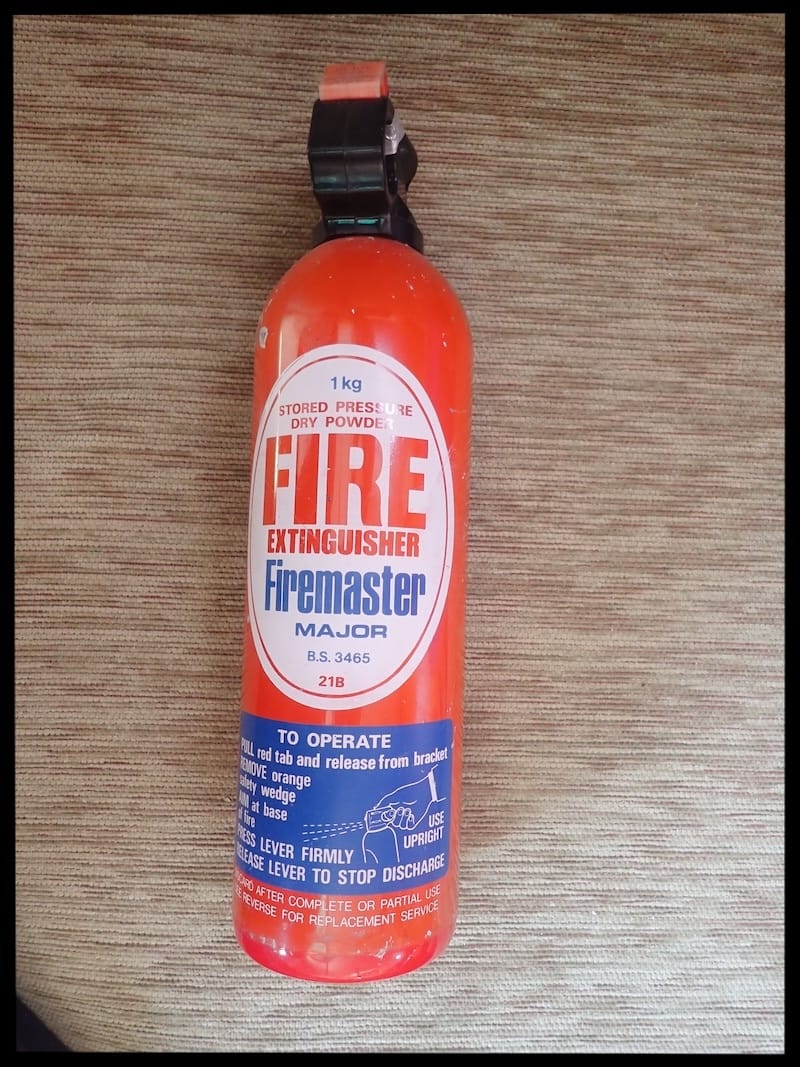
A 1986 1kg Powder Extinguisher Found During An Insurance Survey In 2023
To illustrate the point, the most common portable fire extinguisher found on small boats in the UK is the 1kg ABC dry powder unit. Rated at 5A or occasionally 8A this is a small, lightweight and inexpensive extinguisher. It is usually the cheapest fire extinguisher on offer in the majority of chandleries. When looking to comply with a mandatory standard such as the Boat Safety Scheme, the minimum requirement is to typically carry two or three extinguishers with a combined rating of 10A, 13A or 21A depending on vessel length.

They should carry at least one accredited third-party certification mark (such as a BS ‘Kitemark’, BAFE Approval or MED ‘Ships Wheel’). Some often come with just a CE (Conformité Européenne) mark which carries no guarantee of third party quality testing. Being cheap, approved and small enough to hide beneath a chart table or some other out of the way location, you can see why these little extinguishers are so popular!
The main concern with these extinguishers on boats is that they offer only the most basic level of fire extinguishing capability. On average they have a discharge time of 5 to 10 seconds giving you just one ‘shot’ at tackling the fire. You need to be in exactly the right place and at the optimum distance from the fire before activating the extinguisher.
The prospect of discharging a powder extinguisher in an enclosed space at close range with a fire that is already burning is not appealing. The presence of smoke and other combustion by-products is bad enough when not wearing breathing apparatus, adding a fine powder to that mix would make a bad situation even worse.
It is interesting to note that British Standard 5306-8:2012 (Fire extinguishing installations and equipment on premises) states at para 5.4.3 that:
The discharge of a powder extinguisher within buildings can cause a sudden reduction of visibility and can also impair breathing, which could temporarily jeopardize escape, rescue or other emergency action. For this reason, powder extinguishers should generally not be specified for use indoors, unless mitigated by a health and safety risk assessment.
This all makes a pretty compelling case to avoid using a hand held powder extinguisher within a boat.
It is also unusual to find small metal dry powder extinguishers over 10 years old that are rust free, still have the locking pin and have pressure within the cylinder. There is a school of thought which suggests that all powder extinguishers suffer from powder compaction if left undisturbed for several months. Boat Chat thinks it is good practice to upend them and give the base a couple of taps every month as part of routine fire equipment checks.
So if a powder extinguisher is less than ideal, what should we use instead?
The humble water extinguisher has developed hugely in recent years and modern high pressure water mist extinguishers with fire suppressant additive can now tackle all types of fire in a domestic setting. A typical 2 litre unit (rated at 13A) offers a quantum leap in capability to a similar sized dry powder unit typically for twice the price. This is a small premium to pay for a much better extinguisher.

To illustrate how far some companies have taken the water extinguisher look at Britannia Fire Ltd, a UK company that has been developing extinguishers since 1970. Their latest range, the Britannia P50, has been in production in the UK for over 10 years. It was designed by Britannia founder Roger Carr and is loaded with patented innovation resulting in a greener, lighter, stronger, and safer alternative to traditional metal extinguishers. It has a dual skinned composite body that won’t rust at the base as so many metal extinguishers do in the marine environment. All P50 extinguishers have a user driven service schedule with a simple annual inspection and a mid-life manufacturer overhaul at 10 years, which leads to significant cost savings over the 20-year life cycle of an extinguisher.
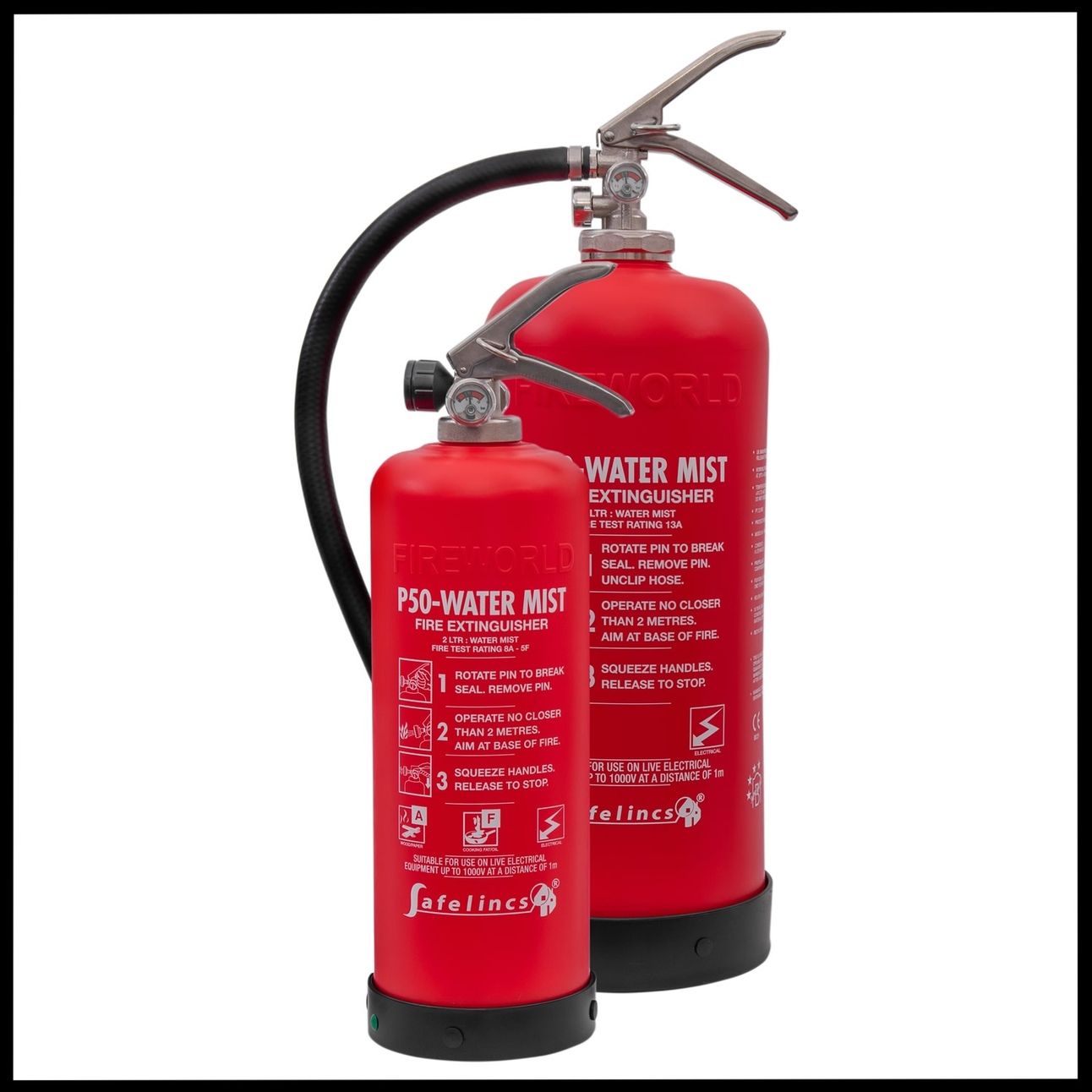
For example, the Britannia P50WM2 is a small hand held 2 litre water mist fire extinguisher. It uses UV treated de-ionised water as an environmentally friendly option for small carbonaceous and cooking oil/fat fire risks. It has an innovative nozzle to allow the water to disperse in a fine mist and leaves little to no residue to clean up which reduces its impact on surrounding equipment. The water mist will extinguish Class A (carbonaceous) and Class F (cooking oil) fires and has also passed the EN3 test for use on live electrical equipment up to 1000V. The P50WM2 is certified to BSI Kitemark, UKCA, EN3 and PED and comes in 2 and 6 litre variants; perfect for any size of small craft needing portable extinguishers.
The only limitation in having water based extinguishers in your boat is that they need to be protected from freezing in the same way that your fresh water supply does. The P50 range has a temperature operating range of +5 to +60oC so keep that in mind when choosing storage locations.
A non-freezing alternative is to use one of the new range of ‘All Fires’ extinguishers from Firexo, which has a temperature operating range of -15 to +60oC. These use a liquid chemical mixture and are certified to tackle all classes of fire, including live electrical equipment up to 1000V, oil and fat fires and lithium-ion battery fires. These offer the ability to rapidly cool a burning battery but may lack the ‘stamina’ to keep it extinguished. A 2 litre All Fires extinguisher will easily fit inside most small craft and also comes in larger 6 and 9 litre sizes, find them on Amazon here: https://amzn.to/3OmYw1U
It also comes in an attractive stainless steel version for the design conscious:
It is worth taking a moment to consider how boaters might have to deal with a lithium-ion battery fire as occurred on the oil tanker ‘S-Trust’. The fire took hold and destroyed all of the bridge navigation, communications and operating equipment whilst the bridge was unoccupied.
This scenario could easily happen on a small craft left unattended whilst the owners are ashore having dinner or shopping, or even worse they are on board and are asleep. This is one reason why smoke detectors, which are not mandatory in law (yet) should be considered an essential item on any small craft.
We need to consider what a boater could do on discovering a lithium-ion battery fire and there are interesting developments in the extinguisher market for products aimed at tackling these fires. Whilst a water mist additive or liquid chemical extinguisher will cool a battery fire and may extinguish it, a battery in thermal runaway is a challenging fire to tackle and is prone to re-ignition. This is likely to be beyond the scope of a ‘conventional’ extinguisher.
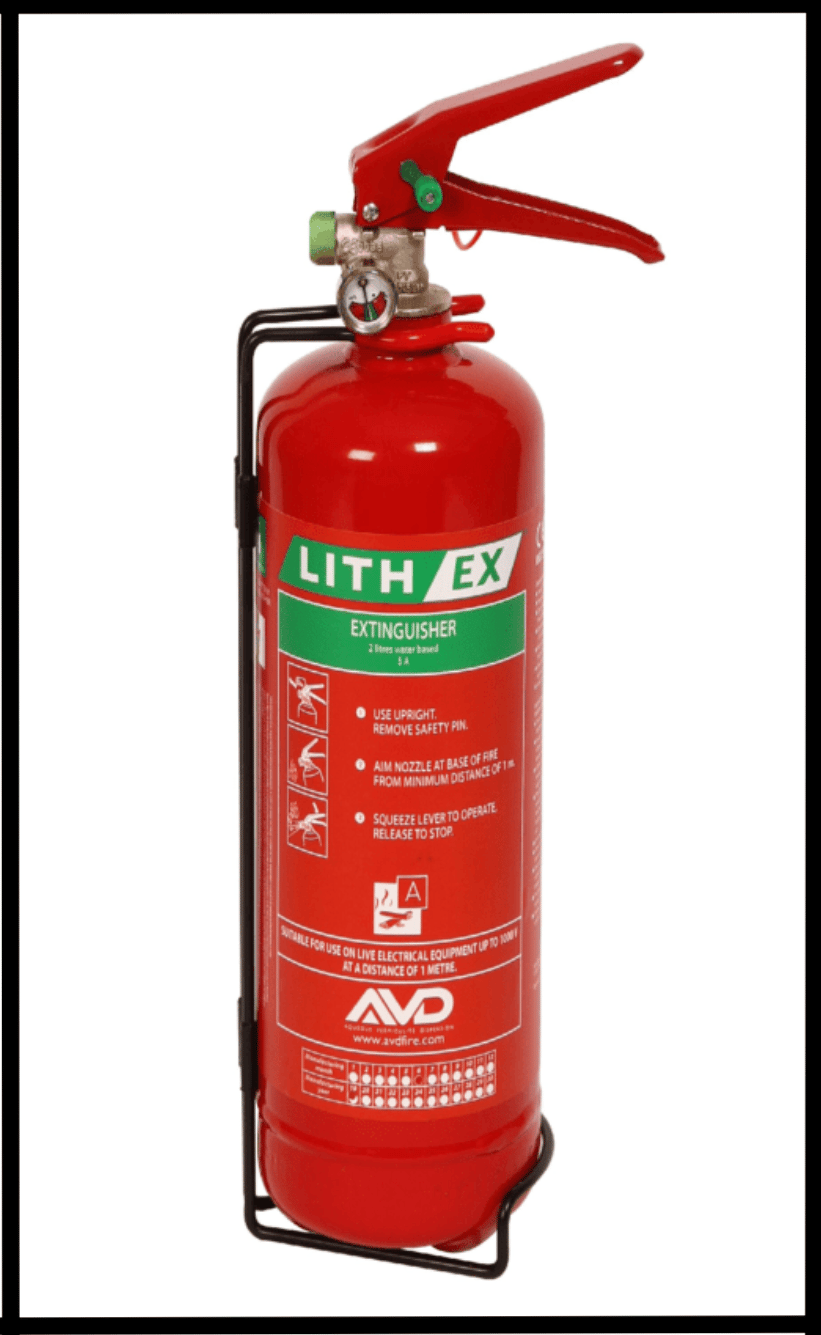
2 Litre AVD Extinguisher
New to the market are AVD (Aqueous Vermiculite Dispersion) extinguishers which spray a 4:1 liquid solution of water and vermiculite with the colour and consistency of a runny chocolate sauce. The solution both rapidly cools the battery through evaporation but also forms a film around the battery, greatly reducing the availability of oxygen and effectively smothering it. This is a patented technology available through AVD Fire Ltd in Stoke-On-Trent:
There is a link to a YouTube video of an AVD extinguisher in action in Further Reading.
So given all of the above, what should the prudent boat owner buy?
A tiered approach to dealing with fires on board is always best so start with an appropriate fire detection capability in the form of an approved optical smoke alarm. A smoke alarm is a low cost insurance policy which could save the lives of you and your family; every boat should have one fitted. They are way more sensitive than the human nose and give you early warning that something is at the smouldering stage before full ignition. This can mean the difference between fighting a fire successfully or not and for the cost involved they are a no brainer. Fireangel optical smoke alarms are recommended by the UK’s Boat Safety Scheme, are made to BS EN 14604:2005 and are best suited to fires in the marine environment. You can get a good value twin pack of FireAngel optical smoke alarms with 'sealed for life' 10 year batteries on Amazon: https://amzn.to/42f9BHQ
Once the alarm has been raised, the fire fighting action plan needs to begin. For this phase having several options is a key enabler to success. A fire blanket and a couple of decent sized, well located extinguishers should be the minimum level of fire fighting inventory in any small vessel. A fire blanket has loads of uses when fire breaks out from smothering people’s clothes to picking up burning equipment to ditch overboard to fighting galley and accommodation fires. Buy a decent size one made to BS1869:2019 like this one:

Find it on Amazon: https://amzn.to/3Q4OoN1
The larger and more complex the vessel layout becomes, the greater the physical quantity and range of extinguishers likely to be needed. Large engine rooms would normally benefit from some automatic and / or remotely activated extinguishing capability. These may well be modern clean agent extinguishers filled with FE36 or FM200 or similar (Halon was banned in 1992 under the Montreal Protocol but every year one turns up on a survey!). Galleys may need their own specialist extinguishers depending on their cooking facilities. On older vessels over 45 feet it would be a prudent investment to commission a fire safety survey by a recognised expert.
In summary, for small boats:
· Develop your own fire plan based on your vessel and how you use it
· Think about where and when you charge lithium-ion battery devices
· Look beyond the minimum requirements of the BSS
· Buy the best quality extinguishers you can afford
· Put signs up by the extinguishers to help crew and family find them
· Install at least one smoke detector
· Install a quality fire blanket in a readily accessible location
· Check your equipment monthly
· Carry out regular fire drills
When the time comes to use an extinguisher, remember PASS
Pull the pin
Aim the extinguisher at the base of the fire
Squeeze the handle whilst aiming at the fire
Sweep back and forth along the base of the fire
YouTube Videos
For more general information about Fire Safety On Boats, here is a video we made last year on YouTube. It looks at 5 essential habits which should help you keep your vessel in good order and safe from burning when you aren’t on your boat and give you a decent chance of fighting and surviving a fire should it break out when you are:

It’s a truism to state that every survey is different because every vessel is different. Knowing what fire safety equipment a vessel should have requires an understanding of the vessel’s design, layout and equipment as well as any mandatory standards to which the vessel need comply. Commercially coded vessels follow strict guidelines and to a lesser extent so do inland waterways vessels in the UK with the Boat Safety Scheme. However private vessels in use on the coast need comply with no mandatory requirements for safety or firefighting equipment.
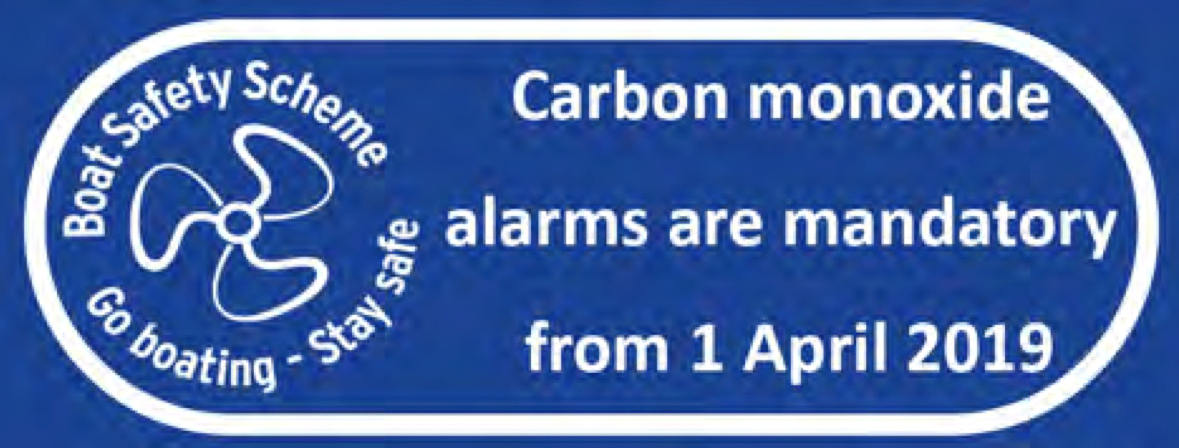
Given that for some vessels there is no mandated equipment a logical approach is to recommend the purchase and carriage of equipment proportionate to the perceived risk involved in a specific vessel. For example, every vessel fitted with an internal combustion engine, generator, LPG gas system or paraffin fuelled lamps really should have a carbon monoxide detector fitted. If a vessel has a fixed LPG system at the very least it should be fitted with a gas leakage tester for Owner tests or a gas test point for a Gas Safe Register technician to test for leaks. A fire blanket is a low cost, low maintenance insurance policy as are fire extinguishers which cost more in the medium term. Optical smoke alarms are very effective on boats and are far more sensitive than the human nose, giving the earliest possible warning that something is getting too hot.
Regulatory standards such as The Boat Safety Scheme recommend that fire extinguishers are carried by quantity and combined fire rating according to the length of the vessel. However, these are all too often the cheap little 1kg ABC dry powder units. Far better would be to carry a larger water mist extinguisher and perhaps a Lith-Ex extinguisher given the prevalence of lithium-ion battery powered devices on a typical family sized yacht.

Whilst private vessels in use in coastal waters do not need to comply with any mandatory standards regarding the scaling of fire extinguishers, standards such as the Boat Safety Scheme stipulate carrying a minimum of three extinguishers with a combined fire rating of at least 21A for a vessel of this size.
All of the 1kg powder units were manufactured in 1986 and at 37 years of age are way beyond any reasonable service life and must be disposed of. It would be a prudent upgrade to carry a modern 2 or 3 litre water mist extinguisher, which has greater utility and leaves a lot less mess than the small powder units.
Action Needed (Minor):
Replace all existing fire extinguishers.
Action Needed (Negligible):
Carry at least one water mist extinguisher.
Great Kit Ideas
With the sailing season just around the corner, it is time to start thinking about new gear for the boat owners or marine surveyors in your life or as a treat for your boat. I have put together several collections on Kit.Co which are all personally recommended items and most of which I own.
From boat safety equipment to books about sailing and the tools and books a marine surveyor needs; there really is something for everyone!
Boaty Terminology
‘Action Stations’ – A pipe (announcement) made over a warship’s internal broadcast system to alert the crew to prepare for imminent danger such as hostile contact, missile impact or an emergency such as fire or flooding. On hearing the pipe, all crew head to pre-assigned positions (their station) to play their part in dealing with the emergency.
Links To Further Reading
This is a great video showing an AVD extinguisher being used on a lithium-ion battery pack in thermal runaway.
How To Support Boat Chat
Boat Chat’s mission is to ‘Help People Understand Boats Better’ by looking at what is going on in the world of boating. Helping people make sense of current maritime events, offering suggestions on how to make the best / minimise the worst boating outcomes and reviewing books and products of interest to boaters.
The easiest way to support Boat Chat is by buying us a beer at:
And Finally…. 👍🏻
Please don’t forget to share this newsletter with your friends, colleagues and contacts who have an interest in boats. If you have any great ideas for future content you think would be good or want to discuss collaboration opportunities, please throw Boat Chat a line at:
And Finally, Finally…
Please note that links to products in this newsletter are typically Amazon Affiliate Links which may earn Boat Chat a small commission should you buy them using the link (this does not affect the price you pay).



